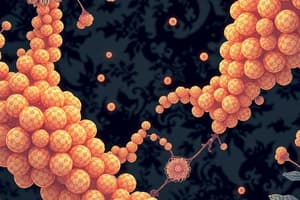Podcast
Questions and Answers
What is a common characteristic of all lipids?
What is a common characteristic of all lipids?
- Soluble in water
- Hydrophobic nature (correct)
- Involvement in glucose metabolism
- Presence of nitrogen in their structures
Which type of lipid serves primarily as a major energy source and is stored in adipose tissue?
Which type of lipid serves primarily as a major energy source and is stored in adipose tissue?
- Triglycerides (correct)
- Phospholipids
- Fatty acids
- Cholesterol
Which lipid plays a critical role in forming the hydrophobic barrier of cell membranes?
Which lipid plays a critical role in forming the hydrophobic barrier of cell membranes?
- Cholesterol
- Fatty acids
- Triacylglycerols (correct)
- Sphingolipids
What function do tocopherols primarily serve in the body?
What function do tocopherols primarily serve in the body?
Which lipid type is crucial for intracellular signaling?
Which lipid type is crucial for intracellular signaling?
What role do bile salts play during lipid digestion?
What role do bile salts play during lipid digestion?
Which of the following substances are absorbed in the form of mixed micelles?
Which of the following substances are absorbed in the form of mixed micelles?
Where are bile acids synthesized and stored?
Where are bile acids synthesized and stored?
What is the fate of lipid digestion products after absorption?
What is the fate of lipid digestion products after absorption?
Which statement best describes fatty acid absorption?
Which statement best describes fatty acid absorption?
What can lead to lipid malabsorption?
What can lead to lipid malabsorption?
What is required for the synthesis of TAG and ChE in intestinal epithelial cells?
What is required for the synthesis of TAG and ChE in intestinal epithelial cells?
Which of the following components is NOT part of micelles?
Which of the following components is NOT part of micelles?
What is the primary product formed by the action of gastric lipase on TAG?
What is the primary product formed by the action of gastric lipase on TAG?
What role does colipase play in lipid digestion?
What role does colipase play in lipid digestion?
Which enzyme is responsible for hydrolyzing cholesterol esters?
Which enzyme is responsible for hydrolyzing cholesterol esters?
What is the primary type of lipid consumed daily, by weight, in the diet?
What is the primary type of lipid consumed daily, by weight, in the diet?
What is the pH at which gastric lipase operates most effectively?
What is the pH at which gastric lipase operates most effectively?
What is one main function of bile acids in intestinal digestion?
What is one main function of bile acids in intestinal digestion?
Which type of lipid is least likely to undergo hydrolysis during gastric digestion?
Which type of lipid is least likely to undergo hydrolysis during gastric digestion?
What percentage of TAG is hydrolyzed during gastric digestion?
What percentage of TAG is hydrolyzed during gastric digestion?
What hormone stimulates the release of bicarbonate in pancreatic juice?
What hormone stimulates the release of bicarbonate in pancreatic juice?
What is the primary component of chylomicrons?
What is the primary component of chylomicrons?
Which apolipoprotein is crucial for activating lipoprotein lipase?
Which apolipoprotein is crucial for activating lipoprotein lipase?
How are chylomicron remnants processed in the liver?
How are chylomicron remnants processed in the liver?
What occurs to nascent chylomicrons after they enter the bloodstream?
What occurs to nascent chylomicrons after they enter the bloodstream?
What triggers the secretion of cholecystokinin?
What triggers the secretion of cholecystokinin?
Which type of enzyme is secreted by skeletal muscle and adipose tissues to break down TAG?
Which type of enzyme is secreted by skeletal muscle and adipose tissues to break down TAG?
Which of the following is NOT a function of apoproteins in chylomicrons?
Which of the following is NOT a function of apoproteins in chylomicrons?
What is the primary role of chylomicrons in the body?
What is the primary role of chylomicrons in the body?
What is the structure of lipoprotein complexes?
What is the structure of lipoprotein complexes?
What is the composition of nascent chylomicrons (CM)?
What is the composition of nascent chylomicrons (CM)?
Which enzyme is activated by apoCII in the chylomicron metabolism process?
Which enzyme is activated by apoCII in the chylomicron metabolism process?
What happens to chylomicron remnants once they reach the liver?
What happens to chylomicron remnants once they reach the liver?
Which activators are specific to lipoprotein lipase (LPL)?
Which activators are specific to lipoprotein lipase (LPL)?
What is the fate of fatty acids after they are hydrolyzed by LPL?
What is the fate of fatty acids after they are hydrolyzed by LPL?
Where is the active site of lipoprotein lipase (LPL) located?
Where is the active site of lipoprotein lipase (LPL) located?
What does activated lipoprotein lipase (LPL) hydrolyze in terms of substrates?
What does activated lipoprotein lipase (LPL) hydrolyze in terms of substrates?
What is the primary role of glycerol after it is released from TAG hydrolysis?
What is the primary role of glycerol after it is released from TAG hydrolysis?
What is the primary function of capillary lipoprotein lipase (LPL)?
What is the primary function of capillary lipoprotein lipase (LPL)?
How is glycerol utilized in the liver following its release from TAG?
How is glycerol utilized in the liver following its release from TAG?
Which receptor types mediate the endocytosis of chylomicron remnants in liver cells?
Which receptor types mediate the endocytosis of chylomicron remnants in liver cells?
What happens to chylomicrons first after they are secreted?
What happens to chylomicrons first after they are secreted?
What is the main energy source derived from the utilization of fatty acids released by lipoprotein lipase?
What is the main energy source derived from the utilization of fatty acids released by lipoprotein lipase?
What do chylomicron remnants lose upon entering the hepatic circulation?
What do chylomicron remnants lose upon entering the hepatic circulation?
Flashcards
Lipids
Lipids
Water-insoluble molecules like fats, oils, and waxes that play crucial roles in energy storage, structural integrity, and cellular signaling.
Fatty Acids (FA)
Fatty Acids (FA)
Fatty acids are long chains of carbon atoms with a carboxyl group at one end. They are the building blocks of many other lipids.
Triacylglycerols (TAG)
Triacylglycerols (TAG)
The primary form of energy storage in the body. They consist of three fatty acids attached to a glycerol molecule.
Phospholipids
Phospholipids
Signup and view all the flashcards
Cholesterol
Cholesterol
Signup and view all the flashcards
What are lipases?
What are lipases?
Signup and view all the flashcards
What does lipase do?
What does lipase do?
Signup and view all the flashcards
What is the role of colipase?
What is the role of colipase?
Signup and view all the flashcards
What does cholesterol esterase do?
What does cholesterol esterase do?
Signup and view all the flashcards
What does phospholipase A2 (PLA2) do?
What does phospholipase A2 (PLA2) do?
Signup and view all the flashcards
How do bile acids aid in lipid digestion?
How do bile acids aid in lipid digestion?
Signup and view all the flashcards
What is Orlistat and how does it work?
What is Orlistat and how does it work?
Signup and view all the flashcards
Where and how do lipids get digested?
Where and how do lipids get digested?
Signup and view all the flashcards
What are bile salts and their composition?
What are bile salts and their composition?
Signup and view all the flashcards
How do bile salts contribute to lipid digestion?
How do bile salts contribute to lipid digestion?
Signup and view all the flashcards
How do bile salts activate lipases?
How do bile salts activate lipases?
Signup and view all the flashcards
What are micelles and their role in lipid digestion?
What are micelles and their role in lipid digestion?
Signup and view all the flashcards
How are short and medium-chain fatty acids absorbed?
How are short and medium-chain fatty acids absorbed?
Signup and view all the flashcards
What is lipid malabsorption and its causes?
What is lipid malabsorption and its causes?
Signup and view all the flashcards
How are lipids re-synthesized in the intestinal epithelial cells?
How are lipids re-synthesized in the intestinal epithelial cells?
Signup and view all the flashcards
What are chylomicrons and their function?
What are chylomicrons and their function?
Signup and view all the flashcards
What is the role of Cholecystokinin (CCK) in lipid digestion?
What is the role of Cholecystokinin (CCK) in lipid digestion?
Signup and view all the flashcards
What is the role of Secretin in lipid digestion?
What is the role of Secretin in lipid digestion?
Signup and view all the flashcards
What are chylomicrons?
What are chylomicrons?
Signup and view all the flashcards
What are lipoprotein complexes?
What are lipoprotein complexes?
Signup and view all the flashcards
What are apolipoproteins?
What are apolipoproteins?
Signup and view all the flashcards
What are nascent chylomicrons?
What are nascent chylomicrons?
Signup and view all the flashcards
What are mature chylomicrons?
What are mature chylomicrons?
Signup and view all the flashcards
What is lipoprotein lipase (LPL)?
What is lipoprotein lipase (LPL)?
Signup and view all the flashcards
What are chylomicron remnants?
What are chylomicron remnants?
Signup and view all the flashcards
What is the role of Apo B-48 and Apo E in chylomicron metabolism?
What is the role of Apo B-48 and Apo E in chylomicron metabolism?
Signup and view all the flashcards
Where are nascent chylomicrons secreted first?
Where are nascent chylomicrons secreted first?
Signup and view all the flashcards
What happens to nascent chylomicrons in the bloodstream?
What happens to nascent chylomicrons in the bloodstream?
Signup and view all the flashcards
What is the final destination of mature chylomicrons?
What is the final destination of mature chylomicrons?
Signup and view all the flashcards
What activates lipoprotein lipase (LPL)?
What activates lipoprotein lipase (LPL)?
Signup and view all the flashcards
What does LPL do to chylomicrons?
What does LPL do to chylomicrons?
Signup and view all the flashcards
What are chylomicron remnants and how do they form?
What are chylomicron remnants and how do they form?
Signup and view all the flashcards
What happens to chylomicron remnants after they release their TAGs?
What happens to chylomicron remnants after they release their TAGs?
Signup and view all the flashcards
How are chylomicron remnants taken up by the liver?
How are chylomicron remnants taken up by the liver?
Signup and view all the flashcards
What is lipoprotein lipase (LPL) and where is it located?
What is lipoprotein lipase (LPL) and where is it located?
Signup and view all the flashcards
How is LPL activated and how does it bind to capillary walls?
How is LPL activated and how does it bind to capillary walls?
Signup and view all the flashcards
What are the substrates of LPL?
What are the substrates of LPL?
Signup and view all the flashcards
What happens to glycerol after LPL breaks down TAGs?
What happens to glycerol after LPL breaks down TAGs?
Signup and view all the flashcards
What happens to free fatty acids (FFA) after LPL breaks down TAGs?
What happens to free fatty acids (FFA) after LPL breaks down TAGs?
Signup and view all the flashcards
Study Notes
Lipid Metabolism Overview
- Lipids are hydrophobic molecules
- Lipids are compartmentalized into membrane-associated lipids or droplets of TAG in adipocytes
- Lipids are transported in plasma via lipoprotein particles
- Common feature of all lipids: insolubility in water (hydrophobic molecules)
- Types of lipids include Fatty acids (FA), Triacylglycerols (TAG or TG), Phospholipids, Sphingolipids, Cholesterol and its derivatives (steroid hormones, Vit D3), and fat-soluble vitamins (A, E and K).
Types of Lipids
- Fatty acids (FA)
- Triacylglycerols (TAG, TG)
- Phospholipids
- Sphingolipids / Steroid hormones / Vit D3 hormone
- Cholesterol
- Fat-soluble vitamins (A, E, K)
Lipid Structures
- Diagrams of fatty acids, triacylglycerol, phospholipid, and steroid structures are presented but omitted in the summary.
Functions of Lipids
- Major source of energy (Fatty acids and TAG)
- Energy storage (TAG in adipose tissue)
- Structural components of cells (phospholipids, cholesterol)
- Provide a hydrophobic barrier that helps partition aqueous contents of cells and subcellular structures
- Regulatory functions (steroid hormones, vitamin D3, carotenoids, tocopherols)
- Substrate for eicosanoid synthesis (arachidonic acid)
- Antioxidant protection (carotenoids, tocopherols)
- Intracellular signaling (phospholipids, membrane phosphatidylinositoles)
Digestion, Absorption, Secretion, and Utilization of Dietary Lipids
- Dietary lipid intake ranges from 60 to 150 grams per day.
- Dietary lipids are about 90% TAG, plus 10% Cholesterol, Cholesterol esters, Phospholipids, and Fatty Acids.
- Only complex lipids undergo digestion (TAG, phospholipids, and cholesterol esters).
- Digestive Processes in the mouth (lingual lipase), stomach (lingual lipase and gastric lipase), and intestine (pancreatic lipase, colipase, phospholipase A2, and cholesterol esterase) are involved in the breakdown of lipids.
- Bile acids are essential for lipid digestion by acting as emulsifiers to aid in the breakdown of lipids which increases the surface area for pancreatic lipases to act on.
- Bile salts participate in the emulsification process of lipids and help in micelle formation, which aid in lipid absorption.
Fate of Products of Lipid Digestion
- Absorption of lipid products in small intestinal epithelial cells occurs as mixed micelles.
- Short and medium-chain fatty acids are absorbed directly without needing micelles.
- Lipids are re-synthesized in enterocytes before their packaging in chylomicrons for transport.
Chylomicron Metabolism
- Nascent chylomicrons, secreted into the lymphatic system, are modified by acquiring Apo CII and ApoE from HDL, becoming mature chylomicrons.
- Mature chylomicrons travel to capillary beds, where the enzymes trigger the breakdown of TAG, releasing fatty acids and glycerol into tissues.
- Chylomicron remnants, deficient in TAG, are transferred back to the liver; absorbed in the liver by receptor-mediated endocytosis, the cholesterol from the food enters the liver and is recycled.
Capillary Lipoprotein Lipase (LPL)
- LPL is synthesized and secreted by adipose tissue, muscle cells and mammary glands, and is not present in the liver or brain.
- LPL is an extracellular enzyme, attached to capillary walls, and activated to break down TAG in VLDL and ChM, into free fatty acids and glycerol, for storage and energy.
- The fatty acids and glycerol are used for cellular energy or storage or transported in the blood via lipoprotein complexes (bound to albumin).
Apoprotein Function
- Apolipoproteins are proteins that bind lipids and play specific roles in lipid transport and metabolism involved in binding/receiving of lipid components (apoB100, apoB48, apoE), activating enzymes (apoCII), exchange of lipids between lipoproteins (apoD, or CETP), and providing recognition signals for uptake by specific tissues (ApoE for the liver to remove/reabsorb cholesterol and TAG components).
Bile Acids and Bile Salts
- Bile acids/bile salts are synthesized in the liver, stored in the gallbladder, and crucial for lipid emulsification.
- The bile acids / bile salts are synthesized from cholesterol and are composed of a sterol ring plus a side chain that is covalently linked to glycine or taurine.
Lipid Malabsorption
- Lipid malabsorption leads to loss of lipids, essential fatty acids, fat-soluble vitamins, and potentially deficiency of essential fatty acids and fat-soluble vitamins.
- Factors of lipid malabsorption include issues with bile secretion, pancreatic juice secretion, and defective intestinal mucosal cell function.
Studying That Suits You
Use AI to generate personalized quizzes and flashcards to suit your learning preferences.




